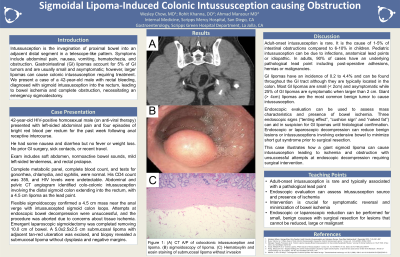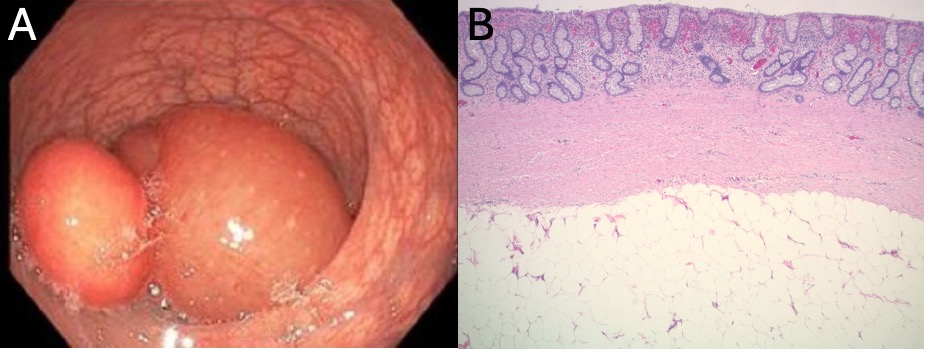Tuesday Poster Session
Category: Colon
P3696 - Sigmoidal Lipoma-Induced Colo-colonic Intussusception Causing Obstruction
Tuesday, October 29, 2024
10:30 AM - 4:00 PM ET
Location: Exhibit Hall E

Has Audio

Wesley Chow, MD
Scripps Mercy Hospital
San Diego, CA
Presenting Author(s)
Wesley Chow, MD1, Rohit Khanna, DO2, Ahmad Mansour, MD2
1Scripps Mercy Hospital, San Diego, CA; 2Scripps Green Hospital, San Diego, CA
Introduction: Intussusception is the invagination of proximal bowel into an adjacent distal segment in a telescope-like pattern. Symptoms include abdominal pain, nausea, vomiting, hematochezia, and obstruction. Gastrointestinal (GI) lipomas account for 5% of GI tumors are usually small and asymptomatic; however, larger lipomas can cause colonic intussusception requiring treatment. We present a case of a 42-year-old male with rectal bleeding, diagnosed with sigmoid intussusception into the rectum, leading to bowel ischemia and complete obstruction, necessitating an emergency sigmoidectomy.
Case Description/Methods: A 42-year-old HIV-positive homosexual male (on medication) presented with left-sided abdominal pain and four episodes of bright red blood per rectum for the past week following anal receptive intercourse. He had intermittent nausea and diarrhea but no fever or weight loss and denied prior GI surgeries, sick contacts, or recent travel. His exam includes soft abdomen with normoactive bowel sounds, mild left-sided tenderness, and a prolapsed intestine on rectal exam. Complete metabolic panel, complete blood count, and tests for gonorrhea, chlamydia, and syphilis, were normal. His CD4 count was 355, and HIV levels were undetectable. Abdominal and pelvic CT angiogram identified colo-colonic intussusception involving the distal sigmoid colon extending into the rectum, with a 4.5 cm lipoma as the lead point. Flexible sigmoidoscopy confirmed a 4.5 cm mass near the anal verge with intussuscepted sigmoid colon loops. Attempts at endoscopic bowel decompression were unsuccessful, and the procedure was aborted due to concerns about tissue ischemia. The patient underwent an emergent laparoscopic sigmoidectomy, removing 10.0 cm of bowel. A 5.0x2.5x2.5 cm submucosal lipoma with adjacent tan-red ulceration was excised, and biopsy revealed a submucosal lipoma without dysplasia and negative margins.
Discussion: Adult-onset intussusception is rare. It is associated with 1-5% of intestinal obstructions compared to 6-10% in children. In adults, 90% of cases have an underlying pathological condition serving as a lead point. GI lipomas have an incidence of 0.2 to 4.4%. While most lipomas are small and asymptomatic, 25% can become symptomatic, often when larger than 2 cm. Diagnosis typically involves cross-sectional imaging and endoscopic evaluation. For lipomas over 4 cm, surgical resection is generally required. This case illustrates how a sigmoid lipoma can cause intussusception, leading to obstruction and ischemia.

Disclosures:
Wesley Chow, MD1, Rohit Khanna, DO2, Ahmad Mansour, MD2. P3696 - Sigmoidal Lipoma-Induced Colo-colonic Intussusception Causing Obstruction, ACG 2024 Annual Scientific Meeting Abstracts. Philadelphia, PA: American College of Gastroenterology.
1Scripps Mercy Hospital, San Diego, CA; 2Scripps Green Hospital, San Diego, CA
Introduction: Intussusception is the invagination of proximal bowel into an adjacent distal segment in a telescope-like pattern. Symptoms include abdominal pain, nausea, vomiting, hematochezia, and obstruction. Gastrointestinal (GI) lipomas account for 5% of GI tumors are usually small and asymptomatic; however, larger lipomas can cause colonic intussusception requiring treatment. We present a case of a 42-year-old male with rectal bleeding, diagnosed with sigmoid intussusception into the rectum, leading to bowel ischemia and complete obstruction, necessitating an emergency sigmoidectomy.
Case Description/Methods: A 42-year-old HIV-positive homosexual male (on medication) presented with left-sided abdominal pain and four episodes of bright red blood per rectum for the past week following anal receptive intercourse. He had intermittent nausea and diarrhea but no fever or weight loss and denied prior GI surgeries, sick contacts, or recent travel. His exam includes soft abdomen with normoactive bowel sounds, mild left-sided tenderness, and a prolapsed intestine on rectal exam. Complete metabolic panel, complete blood count, and tests for gonorrhea, chlamydia, and syphilis, were normal. His CD4 count was 355, and HIV levels were undetectable. Abdominal and pelvic CT angiogram identified colo-colonic intussusception involving the distal sigmoid colon extending into the rectum, with a 4.5 cm lipoma as the lead point. Flexible sigmoidoscopy confirmed a 4.5 cm mass near the anal verge with intussuscepted sigmoid colon loops. Attempts at endoscopic bowel decompression were unsuccessful, and the procedure was aborted due to concerns about tissue ischemia. The patient underwent an emergent laparoscopic sigmoidectomy, removing 10.0 cm of bowel. A 5.0x2.5x2.5 cm submucosal lipoma with adjacent tan-red ulceration was excised, and biopsy revealed a submucosal lipoma without dysplasia and negative margins.
Discussion: Adult-onset intussusception is rare. It is associated with 1-5% of intestinal obstructions compared to 6-10% in children. In adults, 90% of cases have an underlying pathological condition serving as a lead point. GI lipomas have an incidence of 0.2 to 4.4%. While most lipomas are small and asymptomatic, 25% can become symptomatic, often when larger than 2 cm. Diagnosis typically involves cross-sectional imaging and endoscopic evaluation. For lipomas over 4 cm, surgical resection is generally required. This case illustrates how a sigmoid lipoma can cause intussusception, leading to obstruction and ischemia.

Figure: Figure 1: (A) Endoscopic appearance of lipoma and bowel intussusception. (B) Hematoxylin and eosin staining demonstrates submucosal lipoma without deeper invasion
Disclosures:
Wesley Chow indicated no relevant financial relationships.
Rohit Khanna indicated no relevant financial relationships.
Ahmad Mansour indicated no relevant financial relationships.
Wesley Chow, MD1, Rohit Khanna, DO2, Ahmad Mansour, MD2. P3696 - Sigmoidal Lipoma-Induced Colo-colonic Intussusception Causing Obstruction, ACG 2024 Annual Scientific Meeting Abstracts. Philadelphia, PA: American College of Gastroenterology.
